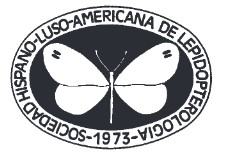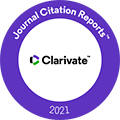Elusive Parnassius mnemosyne (Linnaeus, 1758) larvae: habitat selection, sex determination and sex ratio (Lepidoptera: Papilionidae)
DOI:
https://doi.org/10.57065/shilap.876Keywords:
Lepidoptera, Papilionidae, habitat, sex determination, sex ratio, Czech RepublicAbstract
The charismatic and regionally declining Parnassius mnemosyne (Linnaeus, 1758) is notable for surpluses of males in mark-recapture studies, as well as for poor detectability of its larvae, which develop on spring ephemeral plants, Corydalis spp. In order to study whether the bias towards male exists already in larval stage, we searched for the larvae at three localities in the Czech Republic and attempted to sex the larvae using two alternative methods: (i) by identification of the female specific sex chromatin formed by multiple copies of the W chromosome in polyploid somatic nuclei of the Malpighian tubule cells and (ii) by dissection of ovaries and testes. Finding the larvae in the field was extremely difficult, and 38 person-days of fieldwork yielded only 78 larvae. Consistent with the literature, they dwelled under sparse canopy of oak dominated mature woodlands or on woodland margins. Sexing by genitalia dissection worked well (N = 22) and revealed a prevalence of females (16 vs. 6). In contrast, the identification of sex chromatin was not possible as sex chromatin was absent (N = 56). Further cytogenetic analysis confirmed the haploid number of chromosomes n = 29, which is by one smaller than in the congeneric Parnassius apollo (Linnaeus, 1758). This reduction of chromosome number is probably the result of a fusion of sex chromosomes with a pair of autosomes, a situation not uncommon in Lepidoptera. The female-biased larval sex ratio, contrasting with male biases found so often in adults, is based on just 22 genitally dissected larvae, and may be biased by faster growth rate of males.
Downloads
Global Statistics ℹ️
|
293
Views
|
186
Downloads
|
|
479
Total
|
|
References
ADAMSKI, P., 2004.– Sex ratio of apollo butterfly Parnassius apollo (Lepidoptera: Papilionidae)-facts and artifacts.– European Journal of Entomology, 101: 341-344. DOI: https://doi.org/10.14411/eje.2004.046
AUCKLAND, J. N., DEBINSKI, D. M. & CLARK, W. R., 2004.– Survival, movement, and resource use of the butterfly Parnassius clodius.– Ecological Entomology, 29: 139-149. DOI: https://doi.org/10.1111/j.0307-6946.2004.00581.x
BENES, J., KONVIGKA, M., DVORˇ ÁK, J., FRIC, Z., HAVELDA, Z., PAVLÍGKO, A., VRABEC, V. & WEIDENHOFFER, Z., 2002.– Butterflies of the Czech Republic: Distribution and conservation I., II: 857 pp.
SOM, Prague.
BROMMER, J. E. & FRED, M. S., 1999.– Movement of the Apollo butterfly Parnassius apollo related to host plant and nectar plant patches.– Ecological Entomology, 24: 125-131. DOI: https://doi.org/10.1046/j.1365-2311.1999.00190.x
EHRLICH, P. R., LAUNER, A. E. & MURPHY, D. D., 1984.– Can sex ratio be defined or determined? The case of a population of checkerspot butterflies.– The American Naturalist 124: 527-539. DOI: https://doi.org/10.1086/284292
EMMEL, T. C., ELIAZAR, P. J., BROWN, K. S. Jr. & SUOMALAINEN, E., 1995.– Chromosome evolution in the Papilionidae.– In J. M. SCRIBER, Y. TSUBAKI & R. C. LEDERHOUSE (eds). Swallowtail Butterflies: Their Ecology and Evolutionary Biology: 283-298. Scientific Publishers.
FEDERLEY, H., 1938.– Chromosomenzahlen finnländischer Lepidopteren I. Rhopalocera.– Hereditas 24: 397-464. DOI: https://doi.org/10.1111/j.1601-5223.1938.tb03219.x
FUKOVÁ, I., NEVEN, L. G., BÁRCENAS, N. M., GUND, N. A., DALÍKOVÁ, M. & MAREC, F., 2009.– Rapid assessment of the sex of codling moth Cydia pomonella (Linnaeus) (Lepidoptera: Tortricidae) eggs and larvae.– Journal of Applied Entomology, 133: 249-261. DOI: https://doi.org/10.1111/j.1439-0418.2008.01352.x
GÄRDENFORS, U., 2015.– The 2015 red list of Swedish species. ArtDatabanken, Uppsala.
HEJNX, S. & SLAVÍK, B., 1997.– Kveˇtena Geské Republiky, 1: 557 pp. Academia, Praha.
KONVIGKA, M. & KURAS, T., 1999.– Population structure, behaviour and selection of oviposition sites of an endangered butterfly, Parnassius mnemosyne, in Litovelské Pomoraví, Czech Republic.– Journal of Insect Conservation, 3: 211-223.
KONVIGKA, M., DUCHOSLAV, M., HARASTOVÁ, M., BENES, J., FOLDXNOVÁ, S., JIRKU, M. & KURAS, T., 2001.– Habitat utilization and behaviour of adult Parnassius mnemosyne (Lepidoptera: Papilionidae) in the Litovelské Pomoraví, Czech Republic.– Nota lepidopterologica, 25: 39-51.
KUDRNA, O. & SEUFERT, W., 1991.– Öekologie und Schutz von Parnassius mnemosyne (LINNAEUS, 1758) in der Rhön.– Oedippus, 2: 1-44.
KUUSSAARI, M., SACCHERI, I., CAMARA, M. & HANSKI, I., 1998.– Allee effect and population dynamics in the Glanville fritillary butterfly.– Oikos 82: 384-392. DOI: https://doi.org/10.2307/3546980
KUUSSAARI, M., HEIKKINEN, R. K., HELIÖLÄ, J., LUOTO, M., MAYER, M., RYTTERI, S. & VON BAGH, P., 2015.– Successful translocation of the threatened Clouded Apollo butterfly (Parnassius mnemosyne) and metapopulation establishment in southern Finland.– Biological Conservation, 190: 51-59. DOI: https://doi.org/10.1016/j.biocon.2015.05.011
LUOTO, M., KUUSSAARI, M., RITA, H., SALMINEN, J. & VON BONSDORFF, T., 2001.– Determinants of distribution and abundance in the clouded apollo butterfly: a landscape ecological approach.– Ecography, 24: 601-617. DOI: https://doi.org/10.1034/j.1600-0587.2001.d01-215.x
MAREC, F. & TRAUT, W., 1994.– Sex chromosome pairing and sex chromatin bodies in W-Z translocation strains of Ephestia kuehniella (Lepidoptera).– Genome, 37: 426-435. DOI: https://doi.org/10.1139/g94-060
MATSUMOTO, K., 1985.– Population dynamics of the Japanese clouded apollo Parnassius glacialis Butler (Lepidoptera: Papilionidae). I. Changes in population size and related population parameters for three successive generations.– Research Population Ecology, 27: 301-312. DOI: https://doi.org/10.1007/BF02515468
MEDIOUNI, J., FUKOVÁ, I., FRYDRYCHOVÁ, R., DHOUBI, M. H. & MAREC, F., 2004.– Karyotype, sex chromatin and sex chromosome differentiation in the carob moth, Ectomyelois ceratoniae (Lepidoptera: Pyralidae).– Caryologia, 57: 184-194. DOI: https://doi.org/10.1080/00087114.2004.10589391
MEGLÉCZ, E., NEVE, G., PECSENYE, K. & VARGA, Z., 1999.– Genetic variations in space and time in Parnassius mnemosyne (L.) (Lepidoptera) populations in north-east Hungary: implications for conservation.– Biological Conservation, 89: 251-259. DOI: https://doi.org/10.1016/S0006-3207(99)00006-3
MICHEL, F., REBOURG, C., COSSON, E. & DESCIMON, H., 2008.– Molecular phylogeny of Parnassiinae butterflies (Lepidoptera: Papilionidae) based on the sequences of four mitochondrial DNA segments.– Annales de la Société entomologique de France, 44: 1-36. DOI: https://doi.org/10.1080/00379271.2008.10697541
NGUYEN, P. & CARABAJAL PALADINO, L., 2016.– On the neo-sex chromosomes of Lepidoptera.– In Evolutionary Biology: 171-185. Springer International Publishing, Cham. DOI: https://doi.org/10.1007/978-3-319-41324-2_11
NGUYEN, P., SXKOROVÁ, M., SÍCHOVÁ, J., KUTA, V., DALÍKOVÁ, M., GAPKOVÁ FRYDRYCHOVÁ, R., NEVEN, L. G., SAHARA, K. & MAREC, F., 2013.– Neo-sex chromosomes and adaptive potential in tortricid pests.– Proceedings of the National Academy of Sciences of the United States of America, 110: 6931-6936. DOI: https://doi.org/10.1073/pnas.1220372110
ROBINSON, R., 1971.– Lepidoptera Genetics: 687 pp. Pergamon Press, Oxford.
ROLAND, J., KEYGHOBADI, N., FOWNES, S., 2000.– Alpine Parnassius butterfly dispersal: effects of landscape and population size.– Ecology, 81: 1642-1653. DOI: https://doi.org/10.1890/0012-9658(2000)081[1642:APBDEO]2.0.CO;2
SCOTT, J. A., 1973.– Population biology and adult behaviour of the circumpolar butterfly, Parnassius phoebus F. (Papilionidae).– Entomologica Scandinavica, 4: 161-168. DOI: https://doi.org/10.1163/1876312X74X00010
SEBEK, P., BAGE, R., BARTOS, M., BENES, J., CHLUMSKÁ, Z., DOLEZAL, J., DVORSKX, M., KOVÁRˇ, J., MACHAG, O., MIKÁTOVÁ, B., PERLIK, M., PLATEK, M., POLÁKOVÁ, S., SKORPÍK, M., STEJSKAL, R., SVOBODA, M., TRNKA, F., VLASÍN, M., ZAPLETAL, M., GÍZEK, L., 2015.– Does a minimal
intervention approach threaten the biodiversity of protected areas? A multi-taxa short-term response to intervention in temperate oak-dominated forests.– Forest Ecology and Management, 358: 80-89. DOI: https://doi.org/10.1016/j.foreco.2015.09.008
SÍCHOVÁ, J., NGUYEN, P., DALÍKOVÁ, M. & MAREC, F., 2013.– Chromosomal evolution in tortricid moths: conserved karyotypes with diverged features.– PLoS ONE, 8: e64520. DOI: https://doi.org/10.1371/journal.pone.0064520
SLANCAROVA, J., VRBA, P., PLATEK, M., ZAPLETAL, M., SPITZER, L. & KONVIGKA, M., 2015.– Cooccurrence of three Aristolochia-feeding Papilionids (Archon apollinus, Zerynthia polyxena and Zerynthia cerisy) in Greek Thrace.– Journal of Natural History, 49: 1825-1848. DOI: https://doi.org/10.1080/00222933.2015.1006281
STOKS, R., 2001.– What causes male-biased sex ratios in mature damselfly populations?.– Ecological Entomology, 26: 188-197. DOI: https://doi.org/10.1046/j.1365-2311.2001.00303.x
STOLLE, J., 2004.– Biological flora of Central Europe: Corydalis pumila (Host) Rchb.– Flora-Morphology, Distribution, Functional Ecology of Plants, 199: 204-217. DOI: https://doi.org/10.1078/0367-2530-00148
TRAUT, W. & MAREC, F., 1996.– Sex chromatin in Lepidoptera.– The Quarterly Review of Biology, 71: 239-256. DOI: https://doi.org/10.1086/419371
TRAUT, W., SAHARA, K. & MAREC, F., 2007.– Sex chromosomes and sex determination in Lepidoptera.– Sexual Development, 1: 332-346. DOI: https://doi.org/10.1159/000111765
TRAUT, W., WEITH, A. & TRAUT, G., 1986.– Structural mutants of the W chromosome in Ephestia (Insecta, Lepidoptera).– Genetica, 70: 69-79. DOI: https://doi.org/10.1007/BF00123216
VÄISÄNEN, R. & SOMERMA, P., 1985.– The status of Parnassius mnemosyne (Lepidoptera, Papilionidae) in Finland.– Notulae Entomologicae, 65: 109-118.
VALIMAKI, P. & ITAMIES, J., 2005.– Effects of canopy coverage on the immature stages of the clouded Apollo butterfly [Parnassius mnemosyne (L.)] with observations on larval behaviour.– Entomologica Fennica, 16: 117-123. DOI: https://doi.org/10.33338/ef.84244
VAN SWAAY, C. A. M. & WARREN, M. S., 1999.– Red Data Book of European Butterflies (Rhopalocera), Nature and Environment. Council of Europe Publishing, Strasbourg.
VLASÁNEK, P., HAUCK, D. & KONVIGKA, M., 2009.– Adult sex ratio in the Parnassius mnemosyne butterfly: Effects of survival, migration, and weather.– Israel Journal of Ecology & Evolution, 55: 233-252. DOI: https://doi.org/10.1560/IJEE.55.3.233
VLASÁNEK, P. & KONVIGKA, M., 2009.– Sphragis in Parnassius mnemosyne: male-derived insemination plugs loose efficiency with progress of female flight (Lepidoptera: Papilionidae).– Biologia, 64: 1206-1211. DOI: https://doi.org/10.2478/s11756-009-0207-3
YOSHIDO, A., SAHARA, K. & YASUKOCHI, Y., 2014.– Silk moths (Lepidoptera).– In I. V. SHARAKHOV (ed.). Protocols for Cytogenetic Mapping of Arthropod Genomes: 219-256. CRC Press, Boca Raton. DOI: https://doi.org/10.1201/b17450-7
YOSHIDO, A., MAREC, F. & SAHARA, K., 2016.– The fate of W chromosomes in hybrids between wild silkmoths, Samia cynthia ssp.: no role in sex determination and reproduction.– Heredity, 116: 424-433. DOI: https://doi.org/10.1038/hdy.2015.110
Published
How to Cite
Issue
Section
License
Copyright (c) 2017 P. Vlasánek, A. Bartonová, F. Marec, M. Konvicka

This work is licensed under a Creative Commons Attribution 4.0 International License.
The author SS retains his trademark and patent rights to any process or procedure within the article.
The author retains the right to share, distribute, perform and publicly communicate the article published in SHILAP Revista de lepidopterología, with initial acknowledgement of its publication in SHILAP Revista de lepidopterología.
The author retains the right to make a subsequent publication of his work, from using the article to publishing it in a book, provided that he indicates its initial publication in SHILAP Revista de lepidopterología.
Each submission to SHILAP Revista de lepidopterología must be accompanied by an acceptance of copyright and acknowledgement of authorship. By accepting them, authors retain copyright of their work and agree that the article, if accepted for publication by SHILAP Revista de lepidopterología, will be licensed for use and distribution under a "Creative Commons Attribution 4.0 International" (CC BY 4.0) licence that allows third parties to share and adapt the content for any purpose giving appropriate credit to the original work.
You may read here the basic information and the legal text of the license. The indication of the CC BY 4.0 License must be expressly stated in this way when necessary.
As of 2022, the content of the print and digital version is licensed under a "Creative Commons Attribution 4.0 International License" (CC BY 4.0), licence that allows third parties to share and adapt the content for any purpose giving appropriate credit to the original work.
Previous content in the journal was published under a traditional copyright licence; however, the archive is available for free access.
When using the contents of SHILAP Revista de lepidopterología published before 2022, including figures, tables or any other material in printed or electronic format belong to the authors of the articles, the authors must obtain the permission of the copyright holder. Legal, financial and criminal liabilities in this respect belong to the author(s).
In application of the Principle of Priority of the International Code of Zoological Nomenclature, no other version than the one published by the publisher may be deposited in repositories, personal websites or similar.





























